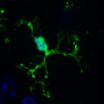(Press-News.org) (Embargoed) CHAPEL HILL – For decades, scientists have known that DNA consists of four basic units -- adenine, guanine, thymine and cytosine. Those four bases have been taught in science textbooks and have formed the basis of the growing knowledge regarding how genes code for life. Yet in recent history, scientists have expanded that list from four to six.
Now, with a finding published online in the July 21, 2011, issue of the journal Science, researchers from the UNC School of Medicine have discovered the seventh and eighth bases of DNA.
These last two bases – called 5-formylcytosine and 5 carboxylcytosine – are actually versions of cytosine that have been modified by Tet proteins, molecular entities thought to play a role in DNA demethylation and stem cell reprogramming.
Thus, the discovery could advance stem cell research by giving a glimpse into the DNA changes – such as the removal of chemical groups through demethylation – that could reprogram adult cells to make them act like stem cells.
"Before we can grasp the magnitude of this discovery, we have to figure out the function of these new bases," said senior study author Yi Zhang, Ph.D., Kenan Distinguished Professor of biochemistry and biophysics at UNC and an Investigator of the Howard Hughes Medical Institute. "Because these bases represent an intermediate state in the demethylation process, they could be important for cell fate reprogramming and cancer, both of which involve DNA demethylation."
Much is known about the "fifth base," 5-methylcytosine, which arises when a chemical tag or methyl group is tacked onto a cytosine. This methylation is associated with gene silencing, as it causes the DNA's double helix to fold even tighter upon itself.
Last year, Zhang's group reported that Tet proteins can convert 5 methylC (the fifth base) to 5 hydroxymethylC (the sixth base) in the first of a four step reaction leading back to bare-boned cytosine. But try as they might, the researchers could not continue the reaction on to the seventh and eighth bases, called 5 formylC and 5 carboxyC.
The problem, they eventually found, was not that Tet wasn't taking that second and third step, it was that their experimental assay wasn't sensitive enough to detect it. Once they realized the limitations of the assay, they redesigned it and were in fact able to detect the two newest bases of DNA. The researchers then examined embryonic stem cells as well as mouse organs and found that both bases can be detected in genomic DNA.
The finding could have important implications for stem cell research, as it could provide researchers with new tools to erase previous methylation patterns to reprogram adult cells.
It could also inform cancer research, as it could give scientists the opportunity to reactivate tumor suppressor genes that had been silenced by DNA methylation.
INFORMATION:
The research was funded by the Howard Hughes Medical Institute and the National Institutes of Health.
Study co-authors from UNC include Shinsuke Ito, Ph.D.; Li Shen, Ph.D.; Susan C. Wu, Ph.D.; Leonard B. Collins and James A. Swenberg, Ph.D.
UNC researchers identify seventh and eighth bases of DNA
2011-07-22
ELSE PRESS RELEASES FROM THIS DATE:
Working mothers and the effects on children
2011-07-22
Parents struggling to combine paid work with bringing up their children now have some positive news thanks to a new study funded by the Economic and Social Research Council (ESRC) on maternal employment and child socio-emotional behaviour in the UK. The research shows that there are no significant detrimental effects on a child's social or emotional development if their mothers work during their early years.
The ideal scenario for children, both boys and girls, was shown to be where both parents lived in the home and both were in paid employment. For children living with ...
Gardening in the brain
2011-07-22
Gardeners know that some trees require regular pruning: some of their branches have to be cut so that others can grow stronger. The same is true of the developing brain: cells called microglia prune the connections between neurons, shaping how the brain is wired, scientists at the European Molecular Biology Laboratory (EMBL) in Monterotondo, Italy, discovered. Published online today in Science, the findings could one day help understand neurodevelopmental disorders like autism.
"We're very excited, because our data shows microglia are critical to get the connectivity ...
Identical virus, host populations can prevail for centuries, WHOI researcher reports
2011-07-22
A Woods Hole Oceanographic Institution (WHOI) scientist, analyzing ancient plankton DNA signatures in sediments of the Black Sea, has found for the first time that the same genetic populations of a virus and its algal host can persist and coexist for centuries. The findings have implications for the ecological significance of viruses in shaping algae ecosystems in the ocean, and perhaps fresh water as well.
"The finding that the DNA of viruses and algal host cells can be preserved in the geological records is of great interest to microbial ecologists," said Marco Coolen ...
Plan to one day end the use of environmentally harmful chemicals on commercial crops developed
2011-07-22
(Edmonton) Two University of Alberta researchers have published a step by step plan to one-day end the use of environmentally harmful chemicals on commercial crops by developing plants that produce their own fertilizer.
U of A plant biologist Allen Good says the energy required to produce nitrogen fertilizers has pushed the world-wide cost for agricultural producers to a $100 billion a year. Good says that while they are necessary for high yields, those nitrogen fertilizers also damage the environment. Emissions from nitrogen fertilizers add to greenhouse gas emissions ...
Repairing our inner clock with a 2-inch fish
2011-07-22
Tel Aviv — Circadian rhythms — the natural cycle that dictates our biological processes over a 24-hour day — does more than tell us when to sleep or wake. Disruptions in the cycle are also associated with depression, problems with weight control, jet lag and more. Now Prof. Yoav Gothilf of Tel Aviv University's Department of Neurobiology at the George S. Wise Faculty of Life Sciences is looking to the common zebrafish to learn more about how the human circadian system functions.
Prof. Gothilf and his Ph.D. student Gad Vatine, in collaboration with Prof. Nicholas Foulkes ...
Washing away good and bad luck
2011-07-22
RIVERSIDE, Calif. (www.ucr.edu) -- Do people believe good and bad luck can be washed away?
Yes, according to an advanced online publication in the Journal of Experimental Psychology that was co-authored by Rami Zwick, a University of California, Riverside marketing professor in the School of Business Administration.
Zwick, working with Alison Jing Xu of the University of Toronto, and Norbert Schwarz of the University of Michigan, designed two experiments that showed risk taking depends on whether participants recalled a past episode of good or bad luck and whether they ...
Do we buy cosmetics because they are useful or because they make us feel good?
2011-07-22
A study by the University of the Basque Country (UPV/EHU) shows that people who use cosmetics buy these products primarily for emotional reasons. The study was carried out on facial creams (hydrating and nutritive ones, coloured or non-coloured, and anti-wrinkle creams) and body creams (firming and anti-cellulite creams).
"The study shows that both the emotional and utility aspect of cosmetic brands have a significant impact on consumer satisfaction, but that the emotional component has a greater effect", Vanessa Apaolaza, a researcher from the UPV and lead author of ...
A new discovery paves the way for using super strong nanostructured metals in cars
2011-07-22
Today, the body of an ordinary family car consists of 193 different types of steel. The steel for each part of the car has been carefully selected and optimised. It is important, for example, that all parts are as light as possible because of the fuel consumption, whereas other parts of the car have to be super strong in order to protect passengers in a collision.
Super strong nanostructured metals are now entering the scene, aimed at making cars even lighter, enabling them to stand collisions in a better way without fatal consequences for the passengers. Research into ...
University of Leicester develops test for classifying force used in bottle stabbings
2011-07-22
Engineers at the University of Leicester have for the first time created a way of measuring how much force is used during a stabbing using a broken bottle. The advance is expected to have significant implications for legal forensics.
A team from the University has conducted a systematic study of the force applied during a stabbing and come up with the first set of penetration force data for broken glass bottles. This work has been published in the International Journal of Legal Medicine (http://www.springerlink.com/content/v21t5g05250n22xw/)
Stabbing is the most ...
Study suggests obesity accelerates progression of cirrhosis
2011-07-22
Researchers from the United States and Europe involved in an NIH-funded multicenter study have determined that increased body mass index (BMI) is an independent predictor of clinical decompensation in patients with compensated cirrhosis, independent of portal pressure and liver function. The findings suggest obesity accelerates cirrhosis progression and measures to reduce BMI could improve the prognosis for patients with advanced liver disease. Study details are available in the August issue of Hepatology, a journal published by Wiley-Blackwell on behalf of the American ...



